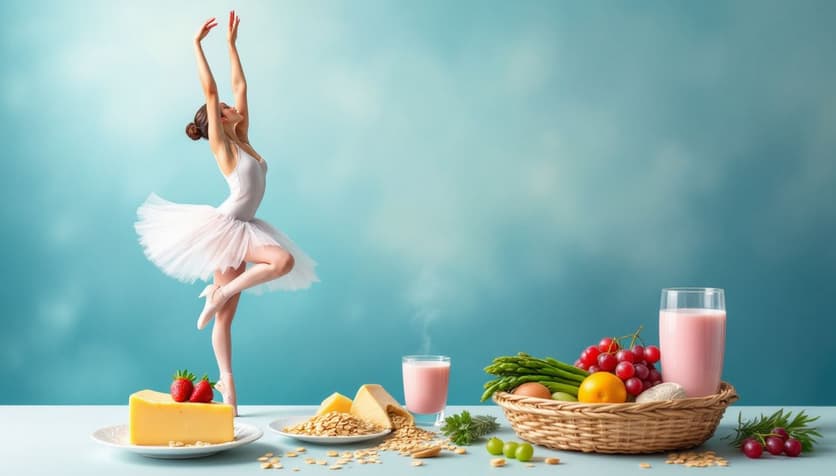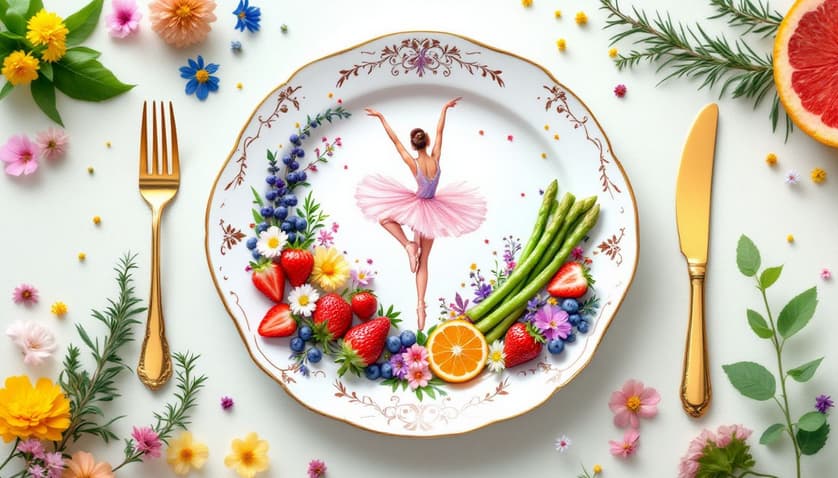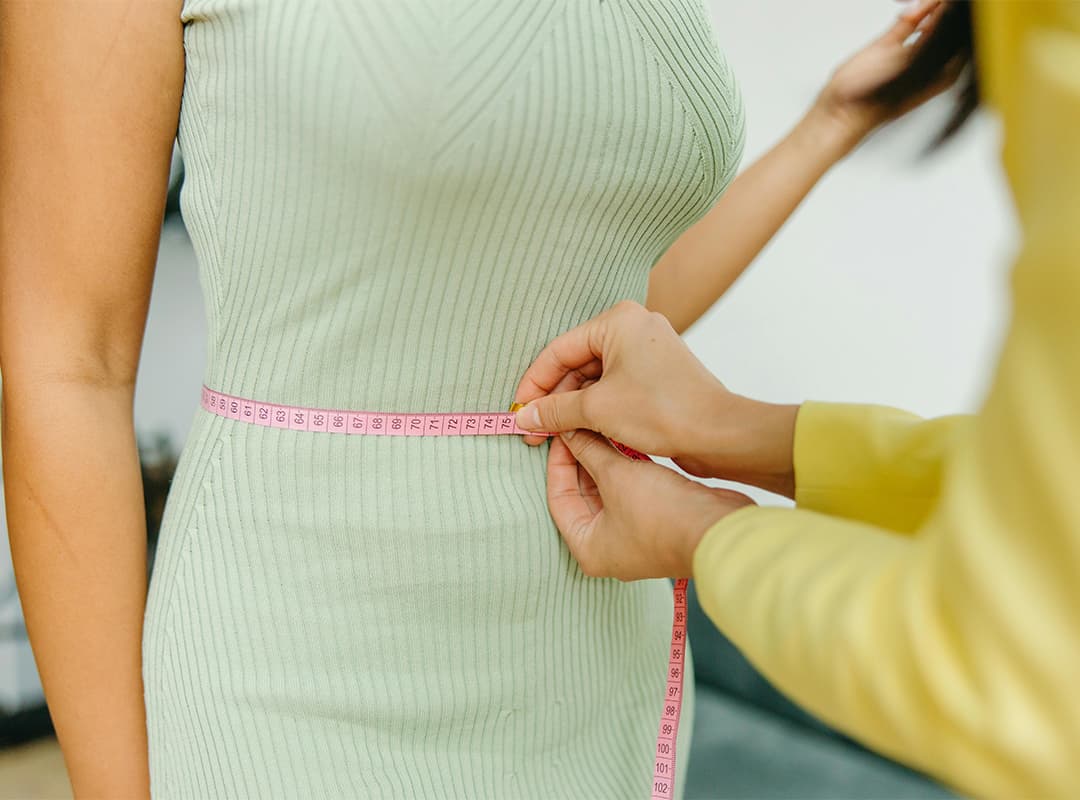Proper nutrition is vital for ballet dancers to fuel their demanding training and performances. This article explores the key elements of good food for ballet dancers, including energy needs, essential nutrients, meal timing, hydration strategies, and the importance of a balanced diet.
Summary Points
- Ballet dancers must balance energy intake with expenditure to avoid under-fueling, which can lead to conditions like Relative Energy Deficiency in Sport (RED-S).
- A dancer’s diet should consist of 55-60% carbohydrates, 12-15% protein, and 30% healthy fats to support energy needs, muscle repair, and overall performance.
- Professional guidance from Registered Dietitian Nutritionists is vital for tailoring nutrition plans that promote health and mitigate the risk of disordered eating among dancers. Embracing the concept of ‘The Healthy Dancer®’ ensures a holistic approach to nutrition and wellness, focusing on sustainable habits, food variety, and a supportive relationship with food.
Understanding Energy Needs for Ballet Dancers

Ballet dancers require significant energy to perform at their best, as they have high physical demands. These demands mean that many dancers must be mindful of their energy intake to avoid under-fueling. Unfortunately, statistics indicate that over half of female dancers and a third of male dancers fail to meet their energy requirements, leading to potential issues such as under-fueling.
The pressure to maintain a thin body and performance anxiety can contribute to under-fueling, as dancers often misjudge their daily calorie needs. The struggle to balance energy intake with expenditure can lead to prolonged calorie deficits, increasing the risk of developing Relative Energy Deficiency in Sport (RED-S), which can impact health and performance. This condition can result in decreased endurance, increased injury, increased risk-taking, and impaired judgment. Additionally, inadequate food intake can negatively impact mental health due to performance anxiety and pressure to maintain a certain body image.
To avoid conditions like RED-S, dancers should balance their energy intake with their energy expenditure by making mindful food choices. A well-balanced diet is key to supporting dancers’ overall health and performance. Maintaining this balance supports their energy levels and demanding training schedules, which is essential for a dancer’s diet.
Macronutrient Essentials for Ballet Performance

A ballet dancer’s diet should ideally include a mix of carbohydrates (55-60%), protein (12-15%), and fats (30%) to support their energy needs. Proper nutrition is essential to ensure sustained energy levels and optimal performance.
Each macronutrient plays a unique role in a dancer’s or food group’s diet.
Carbohydrates: The Preferred Energy Source
Carbohydrates are essential for ballet and dancers to eat, as they provide the preferred energy source necessary for optimal performance. Complex carbohydrates, such as those found in whole grains, fruits, vegetables, legumes, nuts, and seeds, are particularly important. Ballet dancers should aim for 55-60% of their diet to come from carbohydrates.
Incorporating foods like ancient grains, whole grains, and other nutrient-dense options can help dancers maintain their energy levels and ensure they have enough energy to meet their calorie needs. These food choices are not only practical but also delicious and versatile, making it easier for dancers to stick to a healthy and balanced dancer’s diet.
Protein: Building and Repairing Muscle
Protein is crucial for muscle repair and recovery, helping the healthy dancer maintain their physical performance. Ballet dancers should consume between 12-15% of their diet from protein sources to support muscle repair and maintenance. Dancers should aim for 1.2 to 1.7 grams of protein per kilogram of body weight for optimal muscle recovery.
Good protein sources for dancers include chicken, fish, tofu, beans, and legumes. Incorporating a mix of animal and plant proteins, such as legumes, tofu, tempeh, quinoa, nuts, and seeds, helps dancers meet their protein needs effectively. After dance practice, it is beneficial to consume a protein-rich foods snack to aid in muscle recovery, such as a protein smoothie or a turkey sandwich on whole grain bread.
A combination of carbohydrates, protein, and healthy fats after dancing enhances muscle recovery and prepares dancers for their next session. This holistic approach to sports nutrition helps dancers maintain strong bones and supports their overall body health, making it an integral part of their sports nutrition plan.
Healthy Fats: Sustaining Energy and Hormonal Balance
Healthy fats play a vital role in sustaining energy levels and supporting overall health in a healthy dancer and body. Adequate fat intake supports hormonal balance, enhances vitamin absorption, and promotes joint health. Foods like nuts, seeds, avocados, fatty fish, and olive oil are excellent sources of healthy fats.
Dancers should aim to include a variety of nutrient-dense foods in their diet to support their energy needs and maintain hormonal balance. Incorporating these healthy fats into their meals can make a significant difference in their performance,e body weight, and overall well-being.
Timing Your Meals and Snacks
Maintaining energy levels throughout the day is crucial for ballet dancers, and a balanced dancer’s diet plays a significant role in this. Consuming three balanced meals and two to three snacks daily helps dancers sustain their energy and performance. A healthy relationship with food and a flexible eating schedule allows dancers to respond proactively to hunger cues during their rigorous training.
Emergency snacks such as dates, sports gels, or bananas are vital for dancers to stabilize energy levels, especially between meals. Ensuring a balanced intake of carbohydrates, proteins, and fats in their meals and snacks supports their performance and recovery.
Pre-Dance Nutrition
Pre-dance nutrition, as part of a balanced dancer’s diet, provides the energy dancers need for practice. Dancers need to have a meal two to four hours prior to practice. Additionally, a snack should be consumed 30 to 60 minutes before the session. Eating complex carbohydrates 3-4 hours before dancing provides sustained energy for the session.
Simple carbohydrates 30-60 minutes before dancing help avoid digestive issues. Snacks such as foods such as smoothies or carbohydrate-focused options are perfect for consumption within an hour before practice.
This approach helps dancers maintain optimal energy levels and avoid any discomfort during their performance.
Post-Dance Recovery
Post-dance nutrition, including a balanced dancer’s diet, is crucial for recovery and optimal performance in subsequent sessions. Consuming lean proteins such as grilled chicken, white beans, and dairy products is essential for muscle repair and recovery after a dance session. Hydration after dancing aids recovery and prevents muscle cramps and fatigue.
Ideal post-dance snacks include a protein smoothie, Greek yogurt with fruit, or a turkey sandwich on whole-grain bread, offering both protein and carbohydrates for recovery. This combination helps replenish energy stores and repair muscles, preparing dancers for their next practice.
Essential Micronutrients for Ballet Dancers and Bone Health

A balanced dancer’s diet, rich in essential micronutrients such as calcium, vitamin D, and iron, is crucial for the overall health and performance of ballet dancers. Calcium and vitamin D are particularly important for maintaining bone health, which is essential for dancers who are constantly on their feet. Dairy alternatives like soy or oat milk can provide necessary calcium for dancers who avoid dairy.
Supplementing with vitamin D in winter months, when sunlight is limited, helps maintain adequate levels. Iron plays a crucial role for dancers. It helps transport oxygen to the brain and muscles, which enhances their overall performance.
Fortified cereals, lentils, spinach, and tofu are high in plant-based iron. Incorporating a variety of these micronutrients into their diet helps dancers meet their nutritional needs and supports their overall bone health.
Hydration Strategies for Peak Performance
Dancers require a proactive hydration strategy as part of a balanced dancer’s diet, aiming for approximately 3 liters of water daily. Consuming water regularly throughout the day, not just when they feel thirsty, helps maintain hydration levels and supports peak performance. For intense training sessions, it’s beneficial to drink beverages that contain electrolytes to replenish lost minerals and prevent dehydration.
Proper hydration helps dancers avoid muscle cramps, fatigue, and other issues, enabling peak performance.
Common Nutritional Challenges in the Dance World

Many dancers face body dissatisfaction stemming from comparisons within their dance environment. Perfectionism and the pressure for an ideal body can lead dancers to engage in unhealthy eating behaviors. This complex relationship between food and body image increases the likelihood of disordered eating among dancers. Mental health is a vital component of a dancer’s overall well-being, and proper nutrition is crucial for mental clarity, focus, and mood stability.
Pursuing an idealized diet can foster unhealthy eating behaviors, increasing the risk of injury and emotional exhaustion. Young dancers and young athletes who limit caloric intake may experience low energy, inadequate stamina, and higher injury risk.
Over-restriction and rigid food rules can lead to disordered and restrictive eating patterns, such as orthorexia, particularly among dancers focused on weight. It’s essential for dancers to receive qualified nutrition advice to avoid these harmful practices and maintain a healthy diet, especially to prevent restrictive eating.
Mindful Eating for Ballet Dancers
Mindful eating aids digestion, prevents overeating, and reduces digestive discomfort, which is essential for a healthy dancer. Following a balanced diet and being mindful of eating habits can help dancers maintain whole-body wellness. Mindful eating is about focusing on the sensory experiences associated with eating. It also includes being aware of hunger and fullness signals.
This approach promotes a non-judgmental attitude toward food and eating foods, helping dancers develop a healthy relationship with food. Dancers should focus on their own dietary needs rather than comparing their eating habits to those of their peers.
Allowing flexibility in food choices to adapt to social situations and travel can also enhance overall wellness.
Avoiding Harmful Dietary Practices
Dancers have a risk of suffering from eating disorders that is three times higher than that of the general population. Caloric restriction in young dancers can lead to growth issues, low energy and stamina, and a higher risk of injuries. Striving for a perfect diet can lead to unsupportive and restrictive eating habits, increasing the risk of injury and burnout.
Calorie restriction and obsessive dieting can lead to metabolic issues and higher injury risk. It’s crucial for dancers to adopt a healthy and balanced diet, avoiding these harmful practices to maintain their well-being. Additionally, proper nutrition is essential for maintaining mental health, as it helps with mental clarity, focus, and mood stability.
Building a Balanced Meal Plan
Dancers should also have a meal plan to have three meals and two snacks daily to ensure consistent energy intake as part of a balanced dancer’s diet. The recommended meal pattern for dancers includes nutrient-rich carbohydrates, proteins, and a variety of foods to meet their nutritional needs. Complex carbohydrates should make up about 50-60% of a ballet dancer’s total caloric intake per single meal.
A varied diet helps dancers meet nutritional requirements and avoid monotony. Examples of balanced meals and snacks dancers eat include trail mix, grilled chicken, and nutrient-dense options prepared using a food processor. This approach to meal planning and clean eating ensures that dancers maintain optimal energy levels and performance.
Seeking Professional Nutrition Advice
Consulting with Registered Dietitian Nutritionists (RDNs) can help dancers personalize their nutritional needs and become healthy dancers. Registered Dietitian Nutritionists undergo over five years of clinical training, focusing on medical nutrition therapy and nutrition research. Continued education is crucial for dietitians to stay current with nutrition research and practices.
Dancers should evaluate their nutrition for energy levels, hormone health, and digestive health with a dietitian. It’s essential to be wary of nutritional advice that suggests counting calories, tracking macros, or keeping strict meal logs, as these can lead to unhealthy habits.
Summary
Summing up, understanding and meeting the nutritional needs of ballet dancers through a balanced dancer’s diet is crucial for optimal performance and overall health. From macronutrients and micronutrients to meal timing and mindful eating, each aspect of dance nutrition plays a vital role. Avoiding harmful dietary practices and seeking professional advice can further support dancers in maintaining a healthy and balanced diet. Additionally, proper nutrition is essential for maintaining mental health, as it impacts mental clarity, focus, and mood stability.
By incorporating these principles into their daily routine, ballet dancers can ensure they have the energy, strength, and stamina needed to excel in their performances. Embrace these guidelines and let your passion for ballet soar to new heights.



